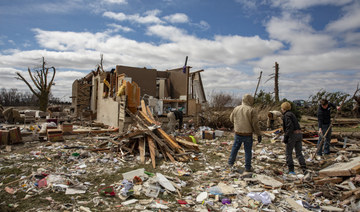Bakhmut: At a health center in the frontline Ukraine city of Bakhmut, doctor Elena Molchanova ushers patients into a narrow office warmed by a wood-burning stove, where she hands out medication and fills in death certificates.
Sometimes her visitors — the last remaining residents in the town shelled daily and cut from essential services — are just seeking shelter from the biting cold.
The 40-year-old doctor is one of just five left in Bakhmut who are now a lifeline to the some 8,000 people local officials say are still in the city.
Bakhmut has been at the heart of a grinding fight between Russian and Ukrainian forces in the past few months in Ukraine’s eastern Donetsk region that Moscow wants to control fully.
When the city was bustling with its pre-war population of some 70,000, the hallways of Molchanova’s clinic were lit, the toilet running and the welcome desk staffed.
Now, she keeps to the one office, with haphazard stacks of medical equipment, sacks of potatoes and papers piled around her.
She worries the large window behind her desk could shatter if one of the shells crashing around the city hits too close.
But she has no plan to leave.
“When I enrolled in medical school, I took the Hippocratic oath, and I cannot betray these people,” she told AFP.
“They come here for medical care, and we provide it the best we can.”
Many of those still living in the midst of fighting in Bakhmut and the nearby town of Soledar — described by a top Ukrainian official the “bloodiest” since Russia invaded last February — are elderly or have disabilities.
Molchanova said the availability of medication and equipment, especially for psychiatric issues or chronic conditions like diabetes, is sporadic at best.
Supplies depend on what comes in from the health ministry, non-profits, or are even recovered from bombed-out buildings — like the two wheelchairs carried in by soldiers on Wednesday afternoon.
“It’s first come first served,” Molchanova said.
“There are not enough insulin syringes and insulin needles. Heart medication ran out very quickly. There is enough paracetamol but that won’t cure the patient.”
Even if Molchanova can’t always offer medical care, she, her husband and two other doctors also provide relief to Bakhmut residents by welcoming them into the basement warren next to the health center where they live.
The low-ceilinged, lamp-lit rooms are lined with high stacks of thick logs to stoke the stoves.
With a generator on hand, residents can charge phones and access a now rare Internet connection as they escape the biting cold.
Icy weather may mean Molchanova no longer worries about refrigerating insulin, but the temperatures have brought in residents suffering with colds or burns from stoves.
For others, it has been deadly and often it is Molchanova who fills out multiple death certificates a day.
Oleksiy Stepanov came to see the doctor for a death certificate for his 83-year-old neighbor, who died at home where the windows had been blown out.
“People are afraid,” Stepanov said.
Tetiana, who asked not to give her last name, came to pick up medicines for her neighbor, an 81-year-old man who is deaf, blind and bed-ridden.
“He has no clue there is a war on, that we’re being shelled,” she said.
Once paid by his family to care for him, she stays now of her own accord.
“I’m afraid of taking this old man with me. He’s in no condition to travel,” she said. “I won’t leave.”
It’s a sentiment Molchanova shares.
Even if she doesn’t understand why some people have not fled, especially families with children, she feels bound to stay and care for them.
“As long as they are here, I’ll be here.”
Last Ukraine doctors offer lifeline in shell-ridden Bakhmut
https://arab.news/wpzcz
Last Ukraine doctors offer lifeline in shell-ridden Bakhmut
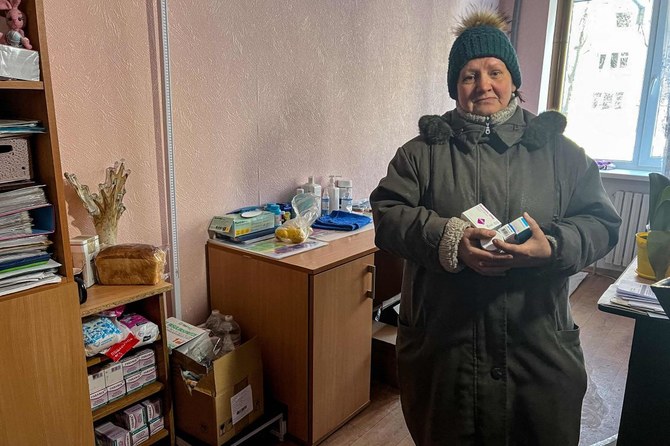
- Five doctors left in Bakhmut who are now a lifeline to the 8,000 people still in the city.
Tornadoes pummel US Midwest, killing at least 5 in Iowa
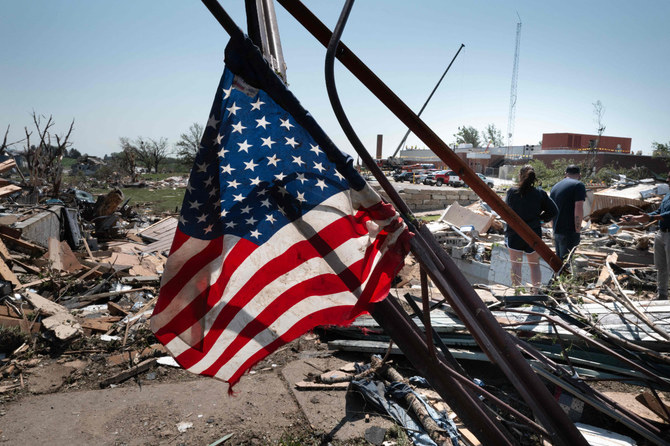
- The storms also knocked out power to tens of thousands of people in Illinois and Wisconsin, officials said
- The tornadoes came at a time when climate change is heightening the severity of storms around the world
GREENFIELD, Iowa: Five people died and at least 35 were hurt as powerful tornadoes ripped through Iowa, with one carving a path of destruction through the small city of Greenfield, officials said Wednesday.
The Iowa Department of Public Safety said Tuesday’s tornadoes killed four people in the Greenfield area, and local officials said a fifth person — a woman whose car was swept away in the wind — was killed by a twister about 25 miles (40 kilometers) away. Officials did not release the names of the victims because they were still notifying relatives.
The Iowa Department of Public Safety said Wednesday it’s believed that the number of people injured is likely higher.
The Greenfield tornado left a wide swath of obliterated homes, splintered trees and crumpled cars in the town of 2,000 about 55 miles (88.5 kilometers) southwest of Des Moines. The twister also ripped apart and crumpled massive power-producing wind turbines several miles outside the city.

Greenfield resident Kimberly Ergish, 33, and her husband dug through the debris field Wednesday that used to be their home, looking for family photos and other salvageable items. There wasn’t much left, she acknowledged.
“Most of it we can’t save,” she said. “But we’re going to get what we can.”
The reality of having her house destroyed in seconds hasn’t really set in, she said.
“If it weren’t for all the bumps and bruises and the achy bones, I would think that it didn’t happen,” she said.
Tuesday’s storms also pummeled parts of Illinois and Wisconsin, knocking out power to tens of thousands of customers in the two states. The severe weather turned south on Wednesday, and the National Weather Service was issuing tornado and flash flood warnings in Texas as parts of the state — including Dallas — were under a tornado watch.
The National Weather Service said initial surveys indicated at least an EF-3 tornado in Greenfield, but additional damage assessment could lead to a more powerful ranking.
The tornado appeared to have been on the ground for more than 40 miles (64 kilometers), AccuWeather Chief Meteorologist Jon Porter said. A satellite photo taken by a BlackSky Technology shows where the twister gouged a nearly straight path of destruction through the town, just south of Greenfield’s center square.
The deadly twister was spawned during a historically bad season for tornadoes in the US, at a time when climate change is heightening the severity of storms around the world. April had the second-highest number of tornadoes on record in the country.
Through Tuesday, there have been 859 confirmed tornadoes this year, 27 percent more than the US sees on average, according to NOAA’s Storm Prediction Center in Norman, Oklahoma. So far, Iowa’s had the most, with 81 confirmed twisters.
On Tuesday alone, the National Weather Service said it received 23 tornado reports, with most in Iowa and one each in Wisconsin and Minnesota.
The tornado that decimated parts of Greenfield brought to life the worst case scenario in Iowa that weather forecasters had feared, Porter said.
“Debris was lifted thousands of feet in the air and ended up falling to the ground several counties away from Greenfield. That’s evidence of just how intense and deadly this tornado was,” Porter said.
People as far as 100 miles (160 kilometers) away from Greenfield posted photos on Facebook of ripped family photos, yearbook pages and other items that were lifted into the sky by the tornado.
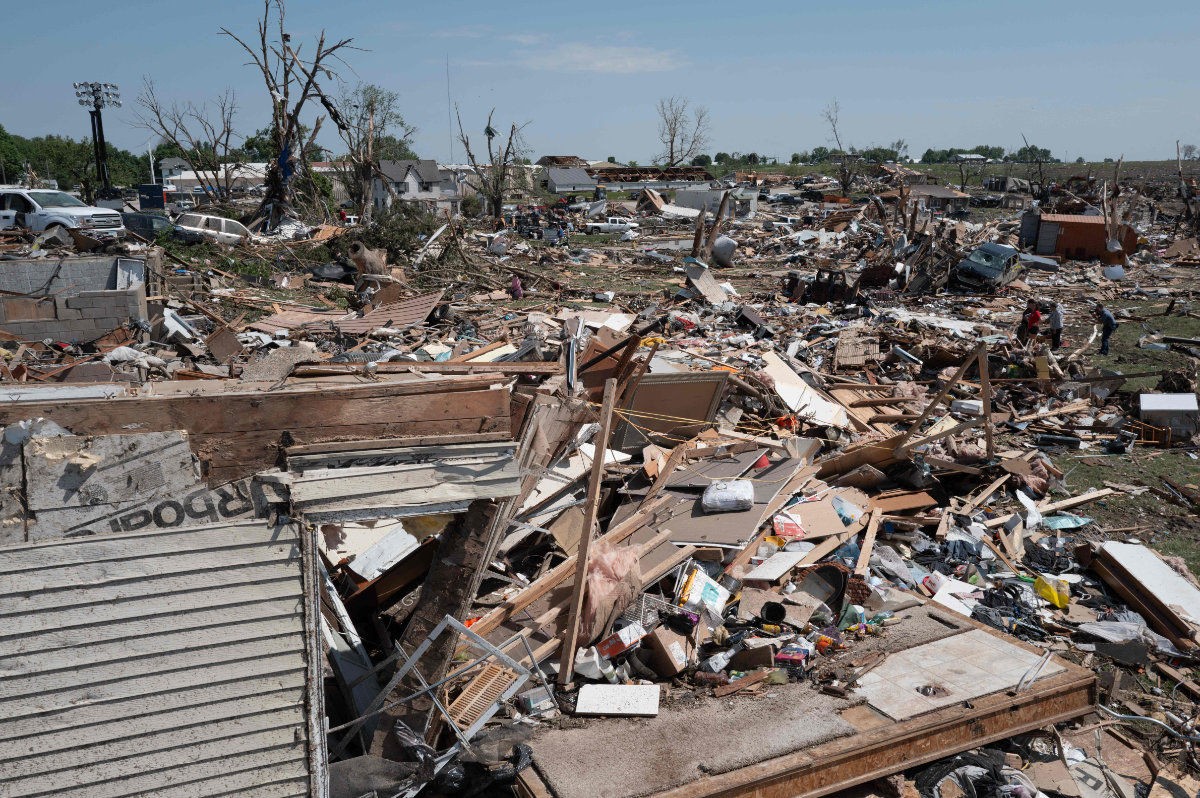
About 90 miles away, in Ames, Iowa, Nicole Banner found a yellowed page declaring “This Book is the Property of the Greenfield Community School District” stuck to her garage door like a Post-It note after the storm passed.
“We just couldn’t believe it had traveled that far,” she said.
White House Press Secretary Karine Jean-Pierre said FEMA’s administrator would head to Iowa on Thursday and that the White House was in touch with state and local officials. She said they were “praying for those who tragically lost their lives” and wished those injured a “speedy recovery.”
Greenfield’s 25-bed hospital was among the buildings damaged, and at least a dozen people who were hurt had to be taken to facilities elsewhere. Hospital officials said in a Facebook post Wednesday that the hospital will remain closed until it can be further assessed and that full repairs could take weeks or months. The hospital, with the help of other providers, set up an urgent care clinic at an elementary school with primary care services to start there Thursday, the post said.
Residential streets that on Monday were lined with old-growth trees and neatly-appointed ranch-style homes were a chaotic jumble of splintered and smashed remnants by Wednesday. Many of the homes’ basements where residents sheltered lay exposed and front yards were littered with belongings from furniture to children’s toys and Christmas decorations.
Dwight Lahey, a 70-year-old retired truck driver, drove from suburban Des Moines to Greenfield to help his 98-year-old mother. She had taken refuge from the twister in her basement, then walked out through her destroyed garage to a nearby convenience store, Lahey said.
“I don’t know how she got through that mess,” he said. His mom was staying in a hotel, uncertain about where she’ll end up with her home gone, he said.
Roseann Freeland, 67, waited until the last minute to rush with her husband to a concrete room in her basement. Seconds later, her husband opened the door “and you could just see daylight,” Freeland said. “I just lost it. I just totally lost it.”
Tuesday’s destructive weather also saw flooding and power outages in Nebraska, damage from tornadoes in Wisconsin and Minnesota, and dust storms in Illinois that forced two interstates to be closed.
The devastation in Iowa followed days of extreme weather that ravaged much of the middle section of the country, including Oklahoma and Kansas. Last week, deadly storms hit the Houston area, killing at least eight and knocking out power to hundreds of thousands.
‘Boiling not warming’: Marine life suffers as Thai sea temperatures hit record

- The once vibrant and colorful corals, about five meters underwater, have turned white in a phenomenon known as coral bleaching
- If water temperatures do not cool, more coral will die, says marine biologist Lalita Putchim
TRAT, Thailand: Aquatic life from coral reefs to fish in the Thailand’s eastern gulf coast is suffering as sea surface temperatures hit record highs this month amid a regional heatwave, worrying scientists and local communities.
The once vibrant and colorful corals, about five meters (16 feet) underwater, have turned white in a phenomenon known as coral bleaching, a sign that their health was deteriorating, due to higher water temperatures, scientists say.
Sea surface temperatures in the Eastern Gulf of Thailand reached 32.73°C (90.91°F) earlier this month while underwater readings are slightly warmer, with dive computers showing around 33°C, data shows.
“I couldn’t find a single healthy coral,” said marine biologist Lalita Putchim of the Department of Marine and Coastal Resources (DMCR) after completing a dive in the gulf coast.
“Almost all of the species have bleached, there’s very little that’s not affected.”
The Trat archipelago is home to over 66 islands, with over 28.4 square kilometers (2,841 hectares) of coral reef, where Lalita has found that up to 30 percent of coral life was bleaching and 5 percent had already died.
If water temperatures do not cool, more coral will die, Lalita said.
“It’s global boiling, not just global warming,” she said.
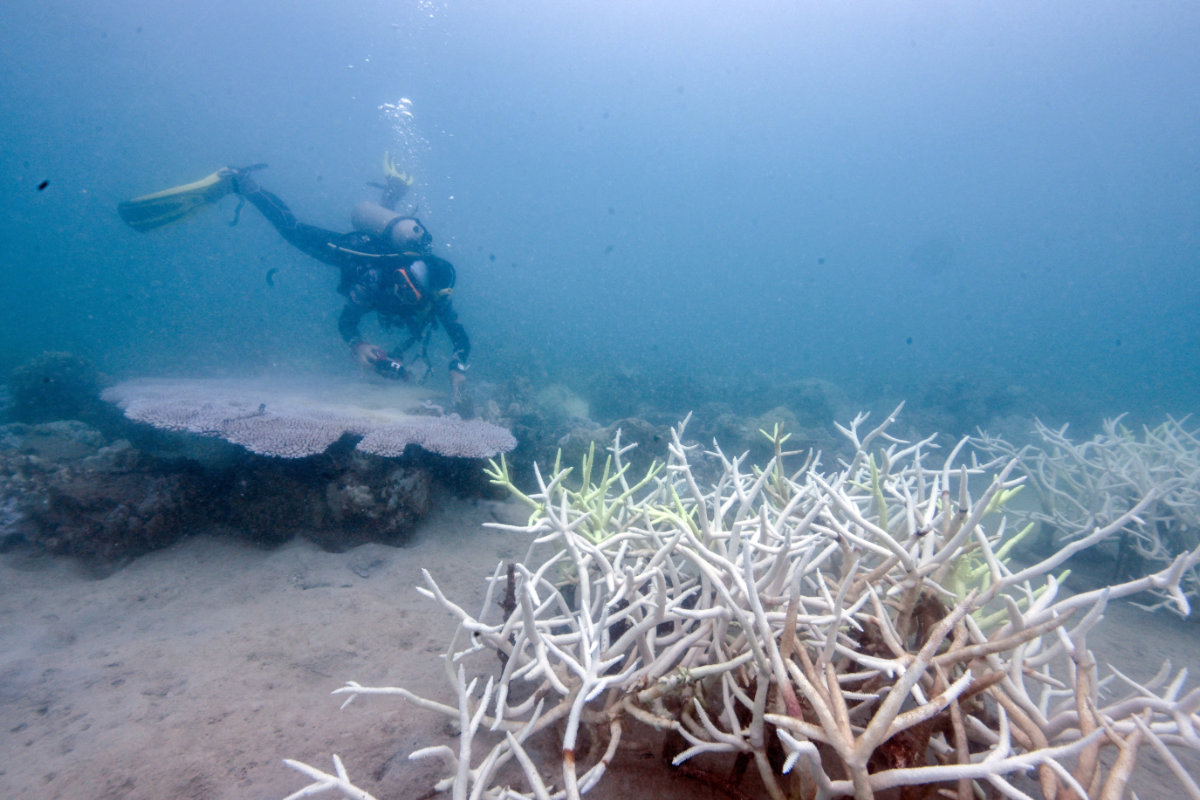
Rising temperatures were also impacting other marine life and the livelihoods of local fishermen including Sommay Singsura.
In recent years, his daily catch of seafood has been dwindling. Previously he had been able to make up to 10,000 baht ($275) a day, but now sometimes he comes back empty handed.
“There used to be jackfish, short mackerel, and many others ... But now, the situation isn’t good. The weather isn’t like what it used to be,” Sommay laments.
Coral reefs are both a food resource and habitat for marine life, as well as being natural barriers preventing coastal erosion, scientists say.
If bleaching causes marine life to decrease, fishermen will need to spend more to get their catch, which could see selling prices rise, said Sarawut Siriwong, the dean of faculty of Marine Technology at Burapha University.
“While this (coral bleaching) would affect food security, at the same time, their (community) income stability is also at stake,” he said.
Daily marijuana use outpaces daily drinking in the US, a new study says

- In 2022, an estimated 17.7 million people reported using marijuana daily or near-daily compared to 14.7 million daily or near-daily drinkers,
- The number of daily users suggests that more people are at risk for developing problematic cannabis use or addiction, says researcher
For the first time, the number of Americans who use marijuana just about every day has surpassed the number who drink that often, a shift some 40 years in the making as recreational pot use became more mainstream and legal in nearly half of US states.
In 2022, an estimated 17.7 million people reported using marijuana daily or near-daily compared to 14.7 million daily or near-daily drinkers, according an analysis of national survey data. In 1992, when daily pot use hit a low point, less than 1 million people said they used marijuana nearly every day.
Alcohol is still more widely used, but 2022 was the first time this intensive level of marijuana use overtook daily and near-daily drinking, said the study’s author, Jonathan Caulkins, a cannabis policy researcher at Carnegie Mellon University.
“A good 40 percent of current cannabis users are using it daily or near daily, a pattern that is more associated with tobacco use than typical alcohol use,” Caulkins said.

The research, based on data from the National Survey on Drug Use and Health, was published Wednesday in the journal Addiction. The survey is a highly regarded source of self-reported estimates of tobacco, alcohol and drug use in the United States.
From 1992 to 2022, the per capita rate of reporting daily or near-daily marijuana use increased 15-fold. Caulkins acknowledged in the study that people may be more willing to report marijuana use as public acceptance grows, which could boost the increase.
Most states now allow medical or recreational marijuana, though it remains illegal at the federal level. In November, Florida voters will decide on a constitutional amendment allowing recreational cannabis, and the federal government is moving to reclassify marijuana as a less dangerous drug.
Research shows that high-frequency users are more likely to become addicted to marijuana, said Dr. David A. Gorelick, a psychiatry professor at the University of Maryland School of Medicine, who was not involved in the study.
The number of daily users suggests that more people are at risk for developing problematic cannabis use or addiction, Gorelick said.
“High frequency use also increases the risk of developing cannabis-associated psychosis,” a severe condition where a person loses touch with reality, he said.
UK defense minister says China sending ‘lethal aid’ to Russia for Ukraine war
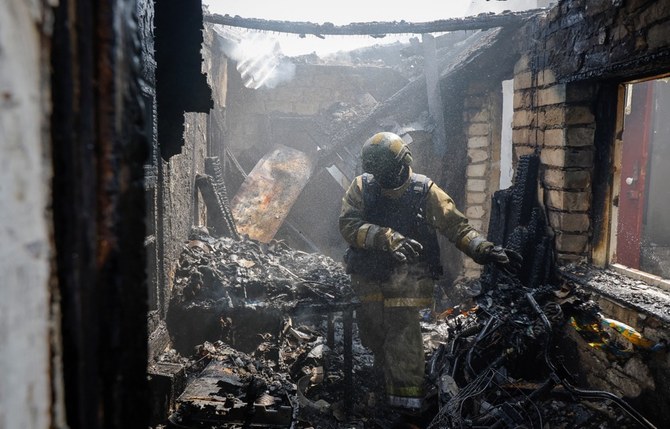
LONDON: China is sending “lethal aid” to Russia for use in its war against Ukraine, Britain’s defense minister Grant Shapps said on Wednesday.
“Today I can reveal that we have evidence that Russia and China are collaborating on combat equipment for use in Ukraine,” he said in a speech at a London conference.
Shapps warned that NATO needed to “wake up” and bolster defense spending across the alliance.
“US and British defense intelligence can reveal that lethal aid is now flowing from China to Russia and into Ukraine.”
He argued that democratic states should make a “full-throated case” for freedoms that are dependent on the international order, meaning “we need more allies and partners” worldwide.
“It’s time for the world to wake up. And that means translating this moment to concrete plans and capabilities. And that starts with laying the foundations for an alliance-wide increase in spending on our collective deterrent,” he said.
China and Russia’s strategic partnership has only grown closer since the invasion of Ukraine, but Beijing has rebuffed Western claims that it is aiding Moscow’s war effort.
China has also offered a critical lifeline to Russia’s isolated economy, with trade booming since the invasion and hitting $240 billion in 2023, according to Chinese customs figures.
US President Joe Biden’s national security adviser Jake Sullivan, however, appeared to take issue with some of Shapps’s comments.
He said the possibility that China might “provide weapons directly — lethal assistance — to Russia” had been a concern earlier, but that “we have not seen that to date.”
The United States did though have a “concern about what China’s doing to fuel Russia’s war machine, not giving weapons directly, but providing inputs to Russia’s defense industrial base,” he added.
Chinese President Xi Jinping and Russian counterpart Vladimir Putin put on a strong show of unity during a meeting in Beijing earlier this month.
Xi said in a statement following talks with Putin during his visit that the two sides agreed on the need for a “political solution” to resolve the war.
Colombia to open embassy in Ramallah

BOGOTA: Colombia, whose president has described Israel’s campaign in Gaza as “genocidal,” said Wednesday it will open an embassy in Ramallah in the Palestinian territories.
Foreign Minister Luis Murillo told reporters that President Gustavo Petro — an ardent critic of Israel’s Benjamin Netanyahu — had given instructions “that we install the embassy of Colombia in Ramallah” in the West Bank.
The announcement came on the same day Ireland, Norway and Spain announced they would recognize a Palestinian state, more than seven months into the devastating Gaza war.
An unprecedented attack by Hamas on Israel on October 7 resulted in the deaths of more than 1,170 people, mostly civilians, according to an AFP tally of Israeli official figures.
The militants also took 252 hostages, 124 of whom remain in Gaza, including 37 the army says are dead.
Israel’s retaliatory offensive has killed at least 35,709 people in Gaza, mostly women and children, according to the Hamas-run territory’s health ministry.
Colombia severed ties with Israel as Petro called Netanyahu “genocidal.”
Earlier this month, he called for the International Criminal Court to issue an arrest warrant for the Israeli leader.
On Monday, the prosecutor of that court said he has requested arrest warrants for Netanyahu, his defense minister and top Hamas leaders.






